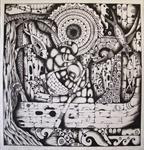As a child, I always enjoyed the museum. Not the guided tour or hours of lagging behind my parents trips to the museum, but the making lemonade out of lemon slices, sugar, and water in the cafeteria with my mates museum days…or the wondering around, using our imaginations to travel back in time trips to the museum. Back then, I never thought much about anything except the interesting objects I found within the museum walls. I spent countless hours in the Bishop Museum believing I had been born too late. Over the years however, my paradigm shifted and I began to question even the concept of such as place as a “museum” where items meant to be used were shown on exhibit. It might be that I am looking for patterns where there are none, however it seems that the Bishop Museum (though the institution is the brain child of native Hawaiian, Bernice Pauahi Bishop) is still very much influenced by the Western, Judeo-Christian world.
The main exhibit surrounds a history of the Hawaiian Islands. It is displayed in Hawaiian Hall - a dark, Victorian, three storied building that is set up with the most “primitive” of displays at the bottom level. It is on the first floor that we find traditional houses and old Gods along with other more “primitive” tools. As we move up to the middle floor (which has become more modern and interactive over the years) we begin to see more of the skill that was necessary to construct all of the utensils, tools and clothing used in everyday living. The top floor is reserved for the “light.” These are the displays of the monarchy and its European trappings...after the introduction of Christianity, of course. It is as though, in ascending the stairs, the visitor travels from the depths of darkness up into the light. The huge sea animals (including a huge shark) suspended from the museum's ceiling are also of interest, reminding us that Hawaii is, literally, in the middle of the ocean.
In Hawaiian Hall, Hawaii is the focus, and there is quite a bit of provenance for many pieces. However, it would be nice if there were more. For those of us who are/were Pacific Island Study majors - we would like to see (for instance) more about how the various ku’pe’e were made and what they were used for, or the time, materials, detail, and prayer that went into making just one pawehe/decorated gourd. It is not as if this information is not available. Perhaps there just isn’t enough room – or interest. Though the museum was created by and for Hawaiians, it is also/has become a tourist attraction and tourists (for the most part) want only so much information. They then want to continue on with the fantasy. Was this Bernice Pauahi Bishop's vision?
As stated above, Hawaiian Hall is huge (by Hawaii’s “museum” standards). It is three stories high and filled with artifacts from very early times until fairly recent. There is provenance offered wherever possible. In another room, about a quarter of the size (if that) of Hawaiian Hall, a place is set aside for “the rest” of Oceania. This is a well lit, quiet space with a number of artifacts, yet given the diversity of the people in this region and the vast amount of ocean in which they navigated, I find neither the space nor the artifacts adequate. There is little to no provenance. The visitor is offered an artifact and, for the most part, left to his or her own devises to figure out what it was used for.
Although museums offer the public a chance to see (albeit enclosed in a glass case) things/artifacts they might otherwise only find in books, ever in the back of my mind are the “curios” of the wealthy (which were the precursors to our modern museums). I wonder what distinguishes art from artifact. I wonder who does the distinguishing. I wonder if there is not another way to "exhibit." For instance, could we not have some sort of “working museum” where the public visits a living, working village? This would keep ancient arts (including the art of the orator) alive, provide a teaching environment, and, hopefully provide a venue for indigenous epistemology and ways of knowing to continue and grow.
While I may question even the concept of the museum, the thinking behind the manner in which art/artifacts are displayed, to its credit Bishop Museum provides wonderful behind the scenes learning experiences, as well as an extensive research library, and an exceptional website.http://www.bishopmuseum.org/








